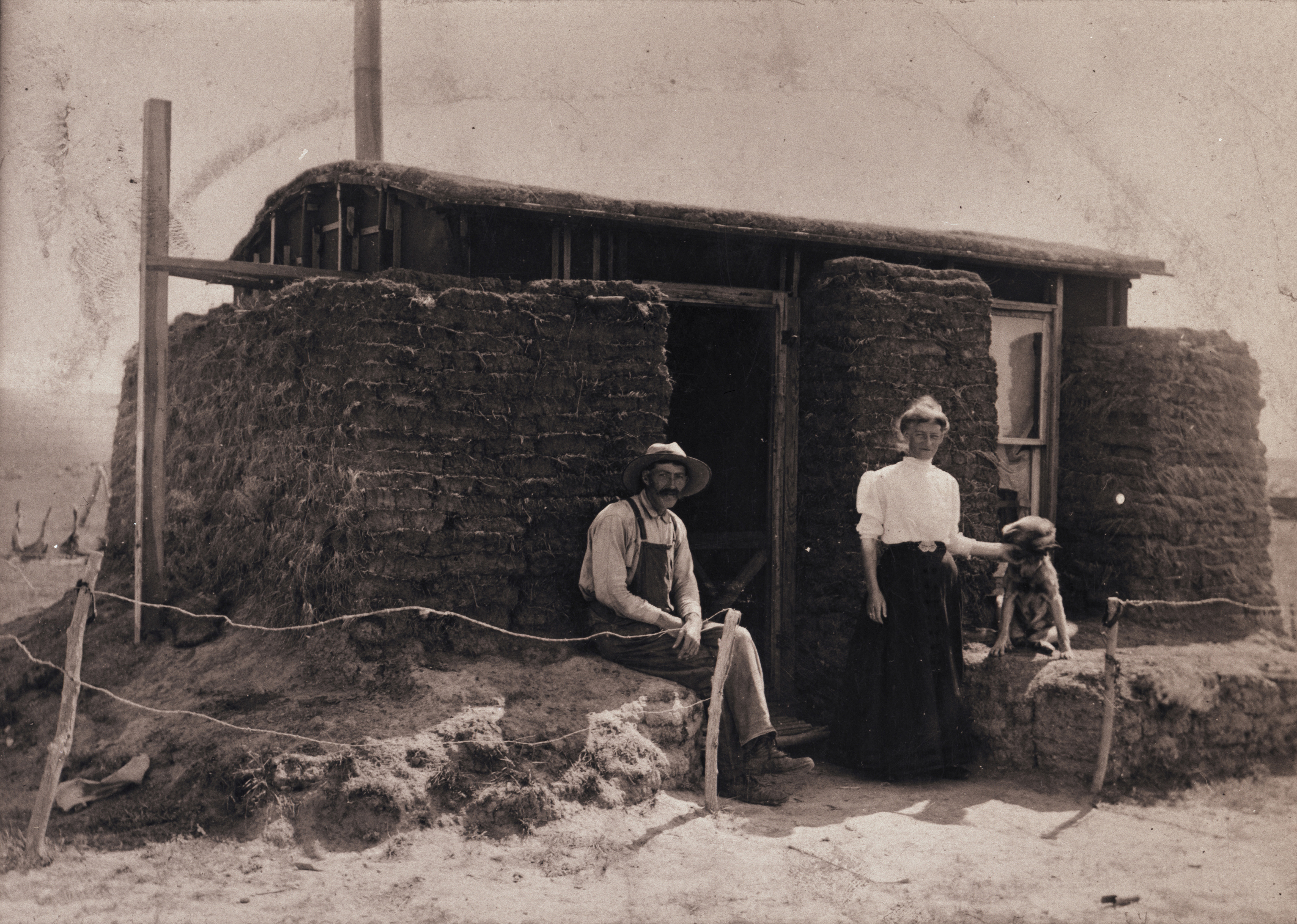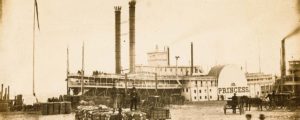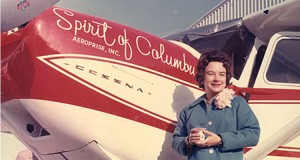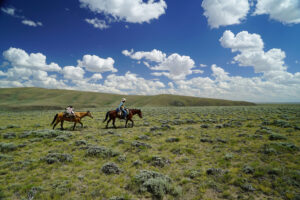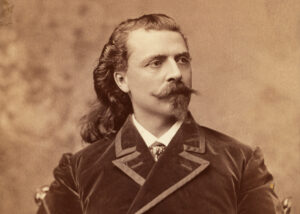Matchmaking was important business out West, as mail-order brides and bridegrooms were willing to put down their money and throw the dice for ‘happily ever after’.
Listed as announcement No. 245 and dated January 7, 1857, this honest and detailed personal advertisement was one of thousands such personals that appeared in mail-order newspapers, magazines and catalogs distributed across the United States beginning in the late 1850s. Such publications were geared to help single men and women find a spouse.
The promise of boundless acreage out West lured countless men away from farms, businesses and homes in the Eastern states as tales of early explorers and fur trappers filtered back from the frontier. Thousands more headed for California—and then Colorado and Montana—after hearing the siren songs of gold and silver. Tracts of timber in the Northwest and a farming paradise in Oregon’s Willamette Valley had even more people packing up and leaving homes east of the Mississippi for the promised land.
The expanses of potential farmland and grazing range, the soaring trees (at least in some places) and the rich ore were all there, and men set about carving their place in the wilderness.By the 1850s, however, Western adventurers lifted their heads from their labors, looked around and felt the absence of one vital element from the bountiful Western territories—women.
According to an estimate in the October 6, 1859, edition of the Daily Alta California, in all the territory west of the Missouri River there was but one woman to every 200 men. At the close of the Civil War the lack of young men back East was just as pronounced. Capitalizing on that gender imbalance were the mail-order matchmakers. When potential couples met sight unseen through personal ads, sometimes things worked out, sometimes they didn’t—there were no money-back guarantees. Yet for many a lonely heart it was worth a roll of the dice. Today matchmaking is big business, with personal ads and online dating sites very much in vogue. But the business of matchmaking got its start in frontier days when prospectors coveted something besides gold and hardworking farmers and ranchers tired of talking to their livestock.
The Matrimonial News popular mail-order newspapers of its niche. Established in England in 1870, it was later published weekly in not only London but was among the most also San Francisco and Kansas City, Mo. The paper’s editors proclaimed that their business was the happiness of their readers, and they strictly enforced a code of rules and regulations posted in each edition. All advertisers were required to provide information on their personal appearance, height, weight, and their financial and social positions, along with a general description of the kind of persons with whom they desired correspondence. The paper published ladies’ personals of 40 words or less at no charge and gentlemen’s personals of 40 words or less for 25 cents. Any personals over 40 words, regardless of the advertiser’s gender, cost a penny a word. The editors numbered each personal in lieu of names and addresses. Interested parties were to send replies to The Matrimonial News offices in sealed envelopes clearly marked with the numbers of the ads.
Each edition of The Matrimonial News opened with the same positive affirmation for both sexes: “Women need a man’s strong arm to support her in life’s struggle, and men need a woman’s love.” Following is a sampling of actual ads that ran in the paper:
219—Is there a gentleman from 30 to 45 years of age, weighing 170 to 200 pounds, measuring 5 feet and 10 inches up, honorable and intelligent, that desires a good wife and housekeeper? Let them answer this number. I can give particulars, photo and best of references if required. Christian preferred.
282—A widower, merchant and stockman lives in Kansas, 46 years old, height 6 feet, weight 210 pounds, brunette, black hair and eyes, wishes to correspond with ladies of same age, without encumbrances and with means, must move in the best society and be fully qualified to help make a happy home: object, matrimony.
257—Wanted someone to love, who will be true and sweet, and not only a darling dove but truly a wise helpmate. She must be of noble birth, whose worth could not be told, as misers count that sordid worth, of stocks and bonds and gold.
268—Two good-looking young men in a Missouri town, having money at their disposal, would be pleased to correspond with two jolly young ladies. Object a quality time and its results.
233—Answer to 82—There is a lad in Missouri with a foot that’s flat, with seeds in his pocket and a brick in his hat, with an eye that is blue and a No. 10 shoe—he’s the “Bull of the Woods” and the boy for you.
266—I want to know some pretty girl of 17 to 20 years. I am 29, 5 feet 9 inches tall, a blonde: I can laugh for 15 minutes, and I want some pretty girl to laugh with me.
252—I move in the best society, am 28 years of age, weight 168 pounds, height 5 feet 8 inches, light complexion, heavy mustache, and would like to correspond with some young lady, object matrimony.
214—Respectable young man, with good position in city, 20 years old, desires the acquaintance of a modest young lady, between the ages of 17 and 21, with home nearby. Object: to attend operas and church; perhaps more.
Churches also helped match lonely male home-steaders with single women seeking a husband. Such was the case early on with Congregational missionary Elkanah Walker. American Board of Commissioners for Foreign Missions (ABCFM) Secretary William Armstrong wrote to Walker on March 20, 1837: “You ought by all means, to have a good, healthy, patient, well-informed, devotedly pious wife. There is a Miss Mary Richardson of Baldwin, Maine, who has offered herself to the board, but we cannot send her single. From her testimonials I should think her a good girl. If you have nobody in view, you might inquire about her.” The shy Walker had told a fellow missionary student he was searching for a wife. According to Mary’s journal, archived at the Washington State University Libraries, Elkanah was described to her as one of those “fine men who must be known in order to be justly appreciated.”
Born on August 7, 1805, in North Yarmouth, Maine, Elkanah grew up on a farm, attended church regularly and was the sixth child in a family of 10. By age 13 he had joined the Congregational Church, and at age 23 he felt compelled to enter the ministry. Elkanah stood 6 feet 4 inches. His height and his relatively advanced age at entering seminary made him painfully shy and unassuming, so much so his friends said it was hard for him even to say “Amen” at the end of his prayers.
Mary was born on April 1, 1811, also into a large family—she had 10 siblings. By age 10 she knew she wanted to become a missionary. After getting high marks in school and graduating,she enrolled in seminary. Once her formal training in missions was complete, Mary applied to the ABCFM for a position out West, but as she was single, the board denied her request.
When Mary Richardson was introduced to Elkanah Walkeron April 22, 1837, it was a blessing, as they shared a zeal for serving the Lord. Not that she instantly recognized that fact.“I saw nothing particularly interesting or disagreeable in the man,” she noted in her journal, “tho I pretty much made up my mind that he was not a missionary but rather an ordinary kind of unaspiring man who was anxious to be looking up a settlement.” Although uncomfortable at their first meeting,Elkanah dared return to the Richardson home that evening with the Rev. Noah Emerson, pastor of the local Congregational Church. The men were to attend a local missions meeting the next day and had been invited to stay at the Richardson home.The following morning Mary and Elkanah had occasion to discuss their mutual desire to be missionaries. During that discussion Elkanah made his intentions known to Mary.
The chance to serve the Lord as a missionary was compelling,but Mary wasn’t completely sold on Elkanah and questioned,at least to herself, engagement to a stranger. “The conflict was rather severe,” she wrote in her April 23 journal entry. “The hand of Providence appeared so plain that I could not but feel that there was something like duty about it, and yet how to go to work to feel satisfied and love him, I hardly knew. But concluded the path of duty must prove the path of peace. Thought I could discover a good foundation for true friendship.”
Mary and Elkanah did not marry right away. Elkanah first had to complete his seminary training. They finally wed on March 5, 1838. Two days later they set off for Oregon Country. The Walkers served as missionaries to the Spokane
Indians for nearly a decade, and the pair had eight children. They left the area soon after Indians attacked the Whitman Mission in Walla Walla and killed 13 fellow missionaries. The couple ultimately relocated to Forest Grove, where Elkanah took a position as pastor of a local church. In 1849 he helped found Tualatin Academy (later Pacific University).
Elkanah died in Forest Grove in 1877. The relationship that had begun in writing had endured for four decades. Mary missed her late husband terribly and reflected on those feelings in her journal. “It seems as though I can’t live without my husband,” she wrote. “I feel so lonely. Think so many things I want to tell Mr. Walker. I realize more and more how much more I loved him than anyone else.” Mary lived another 20 years without him.
Not everyone prompted by a church to correspond or who answered personals enjoyed “happily ever after” endings. In the case of the schoolmarm and the scoundrel, the couple never even made it to the honeymoon. In the spring of 1873 Eleanor Berry responded to a personal ad that ran in the April 12 edition of San Francisco magazine. “Lonesome miner wants wife to share stake and prospects,” the personal read. “Please respond to Louis Dreibelbis in Grass Valley, California.” According to an article in the March/April 1987 edition of the historical journal The Californians, Eleanor was a 22-year-old teacher living in Gilroy, Calif., when she responded to Louis. He soon wrote back, and the pair exchanged letters for three months before Louis asked Eleanor to marry him.
Louis described himself as a wealthy, average-looking man eager to settle down. Eleanor was quite taken with his candor and his praise for her desire to work with children. “Such a woman will make a fine mother,” he wrote. Louis found Eleanor’s letter to be “intelligent and sincere in tone.” The couple set a July 27 wedding date.
After resigning her position as Gilroy’s school mistress, Eleanor packed her trunk and boarded an east bound train to meet Louis for the first time and marry him. Once the train reached Colfax, Calif., the bride-to be and her belongings were transferred to a six-horse stagecoach. Of the 13 passengers, Eleanor was the only woman.
Stage driver Bob Scott promised the passengers a safe trip and assured them highwaymen would not hinder or delay them. Given the cargo, Scott likely sought to convince himself of that notion as well. He wasn’t just carrying passengers, trunks and suitcases. The strongbox aboard contained more than $7,000 in gold to be deposited in a Grass Valley bank.
The first leg of the journey was relatively uneventful. According to one newspaper account, the passengers passed the hours swapping stories about places they had lived or visited. The conversation came to an abrupt halt, however, when the coach jerked to a stop, tumbling Eleanor to the floor of the vehicle.
Soon a gruff voice outside demanded the passengers step out with their hands in the air. All did as they were told. Four armed men wearing gunnysack masks over their heads shouted commands at the passengers and watched them warily. When the driver lowered his arms a bit, a highwayman with a six-shooter hammered back his gun. The driver’s arms shot back up.
“We’ll take your treasure box,” the man with the revolver demanded.
“It’s on the other stage,” Scott insisted.
“Then we’ll keep you here until the other stage comes around,” the bandit warned.
When Scott noticed that the highwaymen had bound their feet in gunnysacks tied off at the ankle—a trick professionals used to leave no visible footprints for a posse to follow—he confessed there was no other stage. Training their weapons on the victims, the bandits ordered everyone away from the coach.
After lining up the travelers against a nearby fence, the gunmen located the strongbox, which was bolted to the coach and had two locks. The holdup men easily opened the outer lock with a pick, then chose to blow the inner lock with gunpowder. Concerned an explosion might destroy her luggage, Berry yelled for the robbers to stop. “Gentlemen, my trousseau is in my trunk,” she reportedly told them. “Won’t you take it down before you blow up the coach?”
The thief with the six-shooter backed away from the safe. “With pleasure, miss,” he replied. Eleanor walked over to the stage as the robber chief jumped off and motioned for the gunman near the strong box to toss down her trunk. As the robber chief reached up to take hold of the trunk, Eleanor noticed a long, jagged scar on the back of his hand. Once she was out of the way, the highwaymen went about their business.
They hastily packed the lock with gunpowder, and seconds after they lit the fuse, a powerful explosion ripped through the stagecoach. They wasted no time searching through the debris to find the gold. After securing their ill-gotten gains in saddlebags, the men mounted up and galloped off into the dusk, disappearing from sight.
Inspecting the damage to the coach, Scott determined that the frame and running gear remained intact. Once he’d settled the spooked horses and re-boarded the passengers as best he could, he drove the coach on to Grass Valley. On arrival Scott reported the holdup, and the local sheriff soon formed a posse to track down the robbers. The stage then deposited Eleanor at the cottage of her betrothed before continuing down the line.
Louis Dreibelbis’ landlady greeted the exhausted bride to-be and informed Eleanor that her fiancé had been called away on business but would return shortly. The woman then escorted Eleanor to a room in which she could prepare for the wedding. After washing away the road dust with a bath the landlady drew for her, Eleanor dressed in her most elegant attire, pinned up her hair and made up her face.
Meanwhile, the landlady readied the parlor for the ceremony. When Eleanor entered the room, she saw two men sitting off to one side, the minister and a witness. Opposite them stood her Louis, dressed in his Sunday best. The pair sized each other up for the first time. He looked considerably older than she expected, but there was a strength of character in his face she had hoped her betrothed would have. Louis on the other hand seemed taken aback, as if shocked at the very sight of her.
The nervous couple took their places before the minister, who opened his Bible and began the proceedings. As Louis recited his vows, Eleanor was struck by his voice. He sounds strangely familiar, she thought.
After the minister pronounced the two “man and wife,” he escorted the newlyweds to a table to sign the marriage license. It was then, when Louis leaned forward to sign his name, Eleanor noticed a long, jagged scar on the back of his hand and realized in an instant where she had seen that mark before. The distraught bride abruptly ran screaming from the parlor and locked herself in one of the bedrooms of the house. The groom was stunned. He had recognized Eleanor as the young woman on the stage coach he had robbed, but he could not imagine she had recognized him. Still, to be safe, he hurried out, mounted his horse and rode off into the night, saying nothing to the landlady, minister or witness when he departed.
The unfortunate bride finally left the bedroom the following morning, the minister and the landlady greeting her with apologies and words of comfort. “Mr. Dreibelbis and I never married,” she insisted to the compassionate pair. “I have no memory of a wedding, only a dream that in the night I was carried off by robbers.” After packing her trunk and soliciting a ride to the stage stop from the minister, she was on her way back home to Gilroy to resume her life as Miss Berry.
Within weeks of the robbery a Wells, Fargo agent caught up with Dreibelbis, who confessed, testified against his fellow bandits and—being a repeat offender in California—agreed to leave the state and never return. He was on the next stage coach back to his home state of Illinois.
Eleanor slipped into Gilroy under cover of darkness, too embarrassed and ashamed to admit to friends and neighbors she had married a thief. To anyone who dared ask what happened, she simply replied that her mail-order groom had not been what she expected. Eventually, however, the truth of the ordeal became public knowledge, and Eleanor was the topic of scandalous gossip. Humiliated beyond words, the young woman decided to end her life.
Only the fast action of a guardian and local doctors kept the distraught mail-order bride from following through on her plan. It’s not known what became of Eleanor after she was brought back to health. Perhaps her broken heart mended and true love eventually made her forget her first trip to the altar—though that might only be wishful thinking.
The New Plan Co., based in Kansas City, Mo., was a matrimonial club that claimed more than 32,000 members during its 1911–17 existence. According to its handbook, though the club served both single women and men, “ladies especially, whose opportunities are somewhat limited as to forming acquaintances,” were encouraged to take full advantage of its catalog of eligible mates. Applicants agreed to pay a $5 fee if membership led to matrimony. Club organizers did require a $1 application fee, to be deducted from the $5 due and payable at the time they married. “This small fee, which is hardly to be considered as a factor,” the catalog explained, “keeps away all frauds and curiosity seekers and is a guarantee to us that all persons joining the club are in earnest and not triflers,and this knowledge is certainly beneficial to all members.”
Once their application fee was paid, members received a certificate good for 12 months. For an additional $1 the club sent out a recent catalog, which contained the name and address of every matrimonially minded man or woman who had sent in an ad. Bachelors and bachelorettes were encouraged to be quick about sending in their own personals, before someone else snapped up the single of their choice. “If you know a good thing when you see it, you will lose no time in quickly taking advantage of their most liberal proposition,”club organizers advised.
Following are some of the New Plan ads:
I am a lonely, unencumbered widow; age 48; weight 165; height 5 feet 6 inches; big blue eyes; brown hair; fair complexion; American; religion, Methodist. I have property worth $30,000. A sunny disposition; considered very good looking. Would like to hear from some good businessman. Object, matrimony.
I do not pose as a beauty, but people tell me that I look well. Enjoy fun and social gatherings. Age, 27; weight, 138; height, 64 inches; brown eyes; brown hair; fair complexion; American; very good disposition; plain dresser, but neat. Prefer country life. Income $20 per month. Matrimonially inclined.
A winsome miss of 22; very beautiful, jolly and entertaining; fond of home and children; from good family; American; Christian; blue eyes; golden hair; fair complexion; pleasant disposition; play piano. Will inherit $10,000. Also have means of $1,000. None but men of good education need to write from 20 to 38 years of age.
Society has no charms for me; prefer a quiet life. Am an American lady, with common school education; well thought of and respected; age, 25; height, 5 feet 9 inches; weight, 155; blue eyes; light hair. Have means of $3,000. Wish correspondence with good-natured, honest, industrious man.
Dear old men, here is your chance to get a true, loving companion. I am a widow by death; age 69 years, but don’t look or feel or act over 40; always in good humor, very loving and kind; a good housekeeper, weight 104, height 5 feet 2 inches, blue eyes, brown hair, nationality German; would like to meet some congenial gentleman near my own age, with means enough to make a good home.
Boys, I am a lonesome little girl, alone in the world and earning my own living and am tired of doing so; my age is 20 years, weight 145, height 5 feet 3 inches, blue eyes, dark hair, good housekeeper, am considered good looking, have some means, also piano; common school education; prefer country life; will marry if suited; no Catholics need to write.
Here comes a sweet lady from the land of flowers and sunshine; age 35; weight 150, height 5 feet 8 inches; brown eyes, brown hair, rosy complexion; a musician, occupation, real estate. Have income, also some means. Object matrimony.
Would like to correspond with a farmer about 30 to 35 years old. Am an American widow of 33; height, 5 feet 2 inches; weight, 200; brown eyes; brown hair; common school education. Personal property worth $1,500. Object matrimony. No flirts need write.
Despite the occasional mismatch or short-lived union,historians at the National Archives in Washington, D.C.,have concluded that mail-order matches resulted in a high percentage of lasting marriages, primarily because the seekers were candid and direct in their explanations of exactly what they expected and wanted from a prospective spouse.And, if requested, the prospective brides and bridegrooms were to send in accurate photos of themselves along with further background information. The safeguards didn’t end there. Often when the pair met, the groom-to-be signed an agreement (witnessed by three upstanding members of that locale) not to abuse or mistreat the bride-to-be. The prospective bride then signed an agreement (also witnessed) not to nag or try to change her intended.
Lonely bachelors and pining maidens were generally willing to consent to whatever terms were necessary in order to secure a spouse. The scarcity of females out West, paucity of young men back East and rapidly changing times forced traditional-minded men and women to rely on unconventional ways of finding a mate. Mail-order couples wed in hopes their mutually beneficial partnership would develop into love. History records that many times the result was indeed a life lived “happily ever after.”
Chris Enss is a prolific author of Western nonfiction, as well as a scriptwriter and comedienne. Recommended for further reading are her books Object Matrimony: The Risky Business of Mail-Order Matchmaking on the Western Frontier, Hearts West: True Stories of Mail-Order Brides on the Frontier and Love Lessons From the Old West: Wisdom From Wild Women.
Originally published in the February 2015 issue of Wild West. To subscribe, click here.

